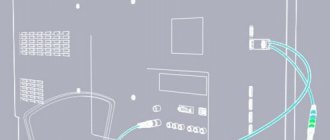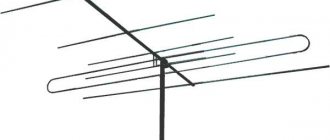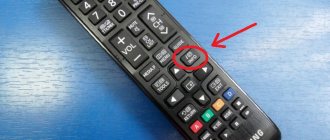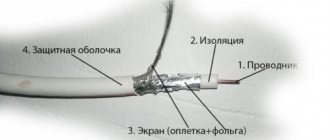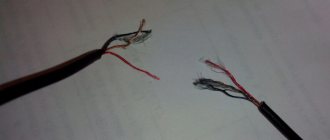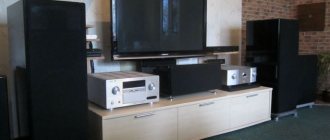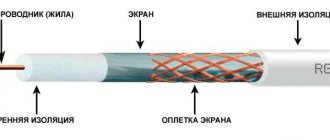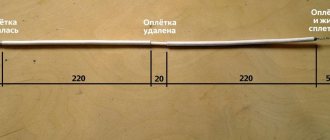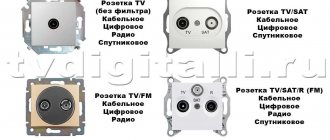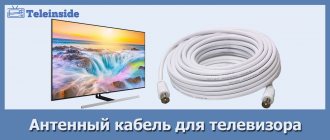What do we need?
Initially, to make digital television, we need:
- Antenna cable
- F – connector for connection.
- Also, sometimes you need a male-female connector for installation in the console itself.
We don’t need anything else; the only tools we need are a pocket knife, or any other, preferably sharp one.
Antenna cable
Before we crimp it, we need to select it. For antennas, so-called coaxial wires are used, which provide a stable signal thanks to their screen. If you break this cable down into its components, it consists of:
- Center copper wire, first conductor, most important
- Dense insulation.
- Aluminum foil is the second conductor
- Aluminum braiding - a “screen”, prevents electromagnetic interference, its use improves the television signal.
- Final plastic insulation protects the entire structure from mechanical and weather damage.
I want to answer the question right away - is it possible to use ordinary copper or aluminum wire? In theory, of course it is possible, but it is not protected from interference, that is, it does not have a “screen”, and the quality of the television signal will drop, and significantly! Therefore, let’s not be wiser, but buy a special antenna cable.
Now there is quite a wide choice on the Russian market - there are both foreign and domestic options (labeled according to European and Russian standards).
If we take Russia (and our standards), then these are options like: - PK - 75 - x - x. If we delve a little deeper into the technical characteristics, the number 75 means characteristic impedance for our coaxial cable.
If we take foreign options (or Russia, but according to EURO standards), then now these are the types: - RG “X”. Usually they go - RG 59, RG 6, RG 11 and so on. They all differ in resistance and maximum signal transmission length, for example RG11 is used in industrial facilities; it can transmit a television signal over a distance of up to 600 meters, with virtually no loss of quality. But it is expensive and for a simple apartment, where there are no such lengths, it is inappropriate to use it!
To summarize, RG6 coaxial cable is now very widely used, I personally recommend it to you, we come to the store and point it out to the seller; in 90% of cases it will be in stock.
Now that we've sorted out the antenna wiring, let's move on to the connectors.
How to properly connect a TV cable
A television cable is an integral part of connecting any antenna to a TV. Without it it will be impossible to watch TV. The whole point of a television cable lies in its basic elements:
- protective shell,
- screen (foil and braid),
- isolation,
- the conductor himself.
But in order to connect it correctly, you need to follow some recommendations. It is a mistake to think that a telephone or Internet cable can create interference if they are laid in one cable - a cable. This is allowed. But the electrical cable can produce interference, but if it is not possible to separate them, then purchase a television cable with a protective sheath more than 1 millimeter thick.
In this video you will learn more about the cable:
It is desirable that it be solid, not lumpy and without unnecessary joints. Do not connect it to electrical wiring. Try to avoid sharp bends, this can be one of the reasons for poor quality TV viewing.
Attention! To avoid connection problems, the main thing is to choose the right antenna cable. Pay attention to all markings. The numbers that are indicated on the product itself indicate what frequency of resistance it is applied to each meter.
To connect it to a TV, you first need to prepare it and purchase all the necessary parts. After selecting the cable, you need to select the plug f connector for the TV cable. They come in different diameters, pay attention to this. If you mounted your TV on the wall, then please note that an angled f-plug will suit you.
Having purchased all the necessary parts, you can begin preparing the cable itself. It consists of several stages. At the first stage, it is necessary to cut the outer shell without damaging the remaining layers. To do this, carefully make a circular cut with a cutter or a sharp knife and remove a piece of the cut off protective layer. Next, open a section of the braid and wrap the foil around the wire itself. The layer must be cleaned in such a way as to damage the foil as little as possible. In the cleaned area, the foil must be wound around the wire, bent in half. Stripping the TV cable takes a couple of minutes.
After all the manipulations have been done, we install the plug for the television cable. If you are interested in the answer to the question of how to crimp a TV cable. Read about this in more detail in the next paragraph.
F-connector and male - female (antenna plug)
The second step is to buy the necessary connectors. One of the most important connections is the so-called F connector. Essentially, it’s just a sleeve that screws onto the cable, so you need to take it with a thread inside, this is important! Let's look at the photo.
If you have receivers or antenna inputs for the F connector, then you may not need anything, just connect, screw in and be happy. But this design cannot be installed in a regular digital set-top box or TV! Therefore, we need another “adapter” or antenna plug.
Many people will now ask me a question - why not immediately buy a plug that goes to the antenna? This is possible, but I haven’t come across any normal ones, for some reason they always break, or the central cable flies out, or the winding of the screen doesn’t fit well. That’s why I always buy an F connector and an adapter for it, it’s not much more expensive, but if necessary, you can connect it to the receiver via the F output and through the antenna cable, that is, it turns out to be a universal adapter. And most importantly, it fits much more securely and better! I recommend it to everyone.
In general, this is what he looks like.
On one side there is an output for connecting to a set-top box or TV. On the other side there is a threaded connection with an F outlet, as well as a hole for the central copper wire.
Now we are completely ready, we proceed to crimping and connecting.
Connecting 2 TVs to the antenna
Often, several television receivers are installed in an apartment, one in each room. To divide the signal into several devices, use a special splitter - splitter .
Connection diagram of the splitter to the antenna and TVs. Plug F of the standard is connected on one side to the coaxial cable, on the other - to the input connector of the splitter
The choice of splitter depends on the number of receivers: how many TVs, so many outputs on the device. But we must not forget that the signal arriving at the antenna will be divided into as many parts as there are connected broadcasting receivers.
And if the signal quality is not the best, then when connecting even a second TV, the image or sound may suffer greatly. The problem can be corrected using an amplifier installed near the antenna (if it is passive).
We talked about the principle of operation of the amplifier in our next article.
Instructions for crimping - connecting with your own hands
SO, the process is not complicated, but you need to do everything carefully, otherwise we will simply ruin the antenna cable, I will list it point by point:
- We take a knife, step back from the end of the cable about 1 - 1.5 cm, and carefully cut only the upper plastic winding in a circle - it is important not to damage the “screen” and the aluminum part underneath it! Let's take it off!
- Now we have an aluminum winding and a screen in front of us; we need to bend them onto the cable itself.
- Next, we have an insulator in front of us, we retreat 0.7 - 1 cm and cut it to the main core, the main thing is not to damage it either. It is certainly thick and durable - but without fanaticism! We remove the insulator.
- We take the F connector and simply screw it onto the bent insulator, it is important that the central wire falls into the hole in the center.
- In fact, everything is ready, you can connect to the receiver or screw the antenna connector on top. Who needs what?
As you can see, there is nothing complicated, but for those who do not quite understand, I present a video version.
Connecting the cable to the TV
To connect the cable to the TV, you must first connect it to the antenna f socket adapter. The connection diagram for a television antenna is very simple and can be found on the Internet. Let's try to describe it in a few words. Connect the cable to the antenna, as well as an amplifier if the antenna is weak. You can watch videos on the Internet for more details.
Every home has not one, but two or three televisions, and there is only one source. What to do in this case? Use a distributor. It has only one input and several outputs, their number depends on how many TVs you want to connect. If the distributor is of poor quality, the TV signal will be poor on all connected devices.
So, unlike Soviet TV models, on modern models all connectors for connecting the antenna cable are located at the back. Each of these connectors is signed. The TV socket is always labeled with the abbreviation ANT. It is into this socket that we connect the cable to the TV.
The socket is very different from other connectors, and it is impossible to confuse them. The latest models of LCD TVs have two sockets for a satellite dish and a simple one. You can connect both, switching from one television to another will be done via the remote control.
How to connect digital TV? To do this, you need a tuner that will pick up the signal. Some models are already produced with a built-in tuner. For earlier models, you need to buy a separate set-top box and connect it to the TV. It is recommended for absolutely everyone to connect to digital TV, because from January 1, 2019, analogue television will stop broadcasting. Digital TV connected to everyone free of charge gives the opportunity to watch 20 channels, including federal TV channels.
How to connect a satellite dish? It is recommended that only specialists set up the dish and connect it. To do this, you need to purchase the entire kit, receiver and plate. This connector also has a round shape, but differs visually from the standard ATN, and the inscription LNB (ANT 2 IN) has an external thread.
A list of broadcasting TV formats that the TV supports can be found either in the specifications, or by looking at what inscriptions are on the back cover. You can install an f tv adapter on old antennas.
With plug
How to connect a TV antenna at home? Let's take a step-by-step look at the instructions for setting up a home TV antenna. We connect the TV plug to the TV, the cable to the outlet. If it is an old model, then use a plug adapter. If it is in good condition, then it will be enough to twist it a little to set up a clear image without interference.
Connecting a standard or satellite television signal to a TV is not difficult if no action was disturbed during the use of the antenna cable connector for the TV and the cable itself was not damaged.
You can also resort to using adapters for f, TV socket adapter, if you have a tulip antenna plug. When connecting to TV, pay attention to cable adapters.
There is a version with and without plug
The bnc plug is needed to connect the camera to the TV for video surveillance. BNC connectors are different. There are more than three types of them: screw, compression, solder, screw-on, with a terminal block. And installation depends on the type you use; you may have to use special adapters.
